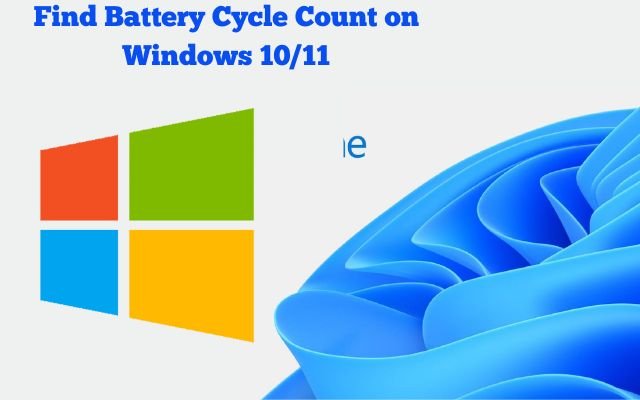Windows Laptop Battery Cycle Count: How to Find It
Learn how to check your Windows laptop battery cycle count using Command Prompt or other tools to monitor battery health easily.

I’ve noticed that my laptop battery doesn’t last as long as it used to and it’s a little frustrating. If you’re having the same issue, there’s an easy way to find out if it’s time to replace your battery or if something else is causing the problem. I found that checking Windows Laptop Battery Cycle Count is a good way to see how healthy it is. Cycle count shows how many times your battery has been charged from 0% to 100% which helps you figure out how much life your battery has left.
I was curious, so I decided to check my battery health on my Windows laptop. It was super easy to do—no special tools needed. A few clicks and I could see where my battery stands. If the cycle count is high, it might be time to replace it. But if it’s still low, your battery might just need some care like not keeping it plugged in all time or letting it run down to 0%.
It really helped me make a better decision about what to do next with my laptop. So, if you’re wondering why your battery doesn’t last as long, checking the cycle count could give you some answers!
Table of Contents
What is the Windows Laptop Battery Cycle Count?
I’ve been curious about my laptop battery lately, especially since it doesn’t last as long as it used to. One thing I learned that really helped me understand how my battery is doing is the concept of a battery cycle. A battery cycle means using the full charge of your battery from 100% to 0%. But it doesn’t have to happen all at once. For example, one complete cycle is reached if your battery decreases from 100% to 50%, is charged back to 100% and then is dropped back to 50%.
The battery cycle count tells you how many times your battery has completed one of these full cycles. The fewer cycles, the better your battery’s health. A battery with fewer cycles still holds a charge closer to its original capacity, while one with more cycles might not hold a charge as well as it did when it was new.
How many cycles it takes for a battery to wear out depends on the type of battery in your laptop. Most batteries should last at least 500 cycles which is quite a bit. For example, Apple rates their MacBook batteries to last for 1,000 cycles. When your battery hits those numbers, it doesn’t stop working completely—it just won’t hold a charge as well. After that, it may not last as long on a single charge, and you might need to think about replacing it.
Why Monitoring Your Battery Cycle Count Matters
I started checking my battery cycle count because it helps me keep track of my laptop’s battery health. I can clearly see how my battery is going by knowing its cycle count. Additionally, it enables me to modify my laptop’s usage to maximize battery life.
If the cycle count is getting close to the limit, I can plan to replace the battery before it’s a bigger issue. If my laptop isn’t lasting as long or acting strange, I can check the cycle count to see if the battery is the problem. It’s been really useful for keeping my laptop working well!
How to Check Battery Health via Cycle Count on Windows 10 or 11
I was curious about my laptop battery’s health and wanted to see how much it’s been used over time. I found that Windows makes it super easy to check your battery’s cycle count, which is helpful whether you’re trying to get a sense of how much wear your battery has or if you’re looking at a used laptop before buying it. All you need is a quick command, and you can check it right from your laptop.
To do this on Windows 10 or 11, you just open Command Prompt by searching for it in the Start menu. Once it’s open, you type this command and hit Enter:
powercfg /batteryreport
After running the command, you’ll need to go to your user folder in File Explorer, where you’ll find a file named battery-report.html. You’ll also see the location of the file listed in the Command Prompt window, something like this:
C:\Users\[YOUR USERNAME]\battery-report.html
When you double-click this file, it will open in your default browser. You’ll see some basic info at the top, like your PC’s name and when the report was generated. If you scroll down a bit, you’ll find the “Installed batteries” section, where you’ll see two important numbers: Design Capacity and Full Charge Capacity.
Design Capacity is original maximum charge your battery could hold when it was new. Full Charge Capacity tells you how much charge your battery can hold now. If these numbers are pretty close, it means your battery is still in good shape. But if the Full Charge Capacity is much lower than the Design Capacity, it means your battery’s health has dropped a lot.
Also, you’ll see the Cycle Count, which tells you how many times your battery has gone through a full charge cycle. If the cycle count is high, that’s probably why your battery doesn’t last as long. With a high cycle count, the battery’s maximum capacity is likely lower than it originally was. Below all of this, the report also gives you details on recent battery usage, which can help if you’re troubleshooting any specific issues. It was really helpful for me to understand how my battery’s been doing!
I wanted an easy way to check my laptop’s battery cycle count, so I decided to try a few methods that are built into Windows. Here’s how I did it:
How to Check Battery Cycle Count via PowerShell
PowerShell is another tool in Windows that can give you the same battery report.
- Open PowerShell:
Start by selecting the Start Menu, typing “PowerShell,” then right-clicking “Windows PowerShell” and choosing “Run as administrator.” - Generate Battery Report:
Typepowercfg /batteryreportand press Enter. - Locate and Open the Report:
Follow the same steps from the Command Prompt method to find and open the battery report. The cycle count will be in the “Installed Batteries” section.
How to use Third-Party Software to Check Battery Cycle Count
If you prefer dedicated apps I found a few third-party tools that give easy-to-read battery info, including cycle count.
- Popular Tools:
- HWMonitor: This app shows real-time hardware info, including battery cycle count.
- BatteryInfoView: This small program gives detailed battery stats like cycle count and discharge rates.
- BatteryBar: A desktop battery meter that shows power status and cycle count.
- Using BatteryInfoView:
- Download and Install: Go to the official BatteryInfoView website and download the program. Open the file and follow the installation steps.
- Check the Cycle Count: Launch the app, and you’ll see your battery details. Look for the cycle count under a section labeled “Cycle Count” or something similar.
These methods made it easy for me to track my battery’s health and cycle count!
- Turn Off This iOS 18 Feature for Improving iPhone Battery Life
- How to Spot Fake QR Codes and Protect Your Data
- Secret iPhone Codes Apple Doesn’t Want You to See
How to Find the Missing Cycle Count in Your Windows Battery Report
I ran into an issue when trying to generate a battery report on my Windows laptop—there was no cycle count included. If this happens to you too, don’t worry. The first thing I did was check for any outdated drivers. I paid extra attention to the battery driver and the chipset driver, as those are key to getting the right info. After updating any drivers that needed it, I restarted my laptop and ran the battery report again.
If that didn’t work, the next step I took was updating the UEFI/BIOS, just in case that was causing the issue. I didn’t get lucky with just the drivers and BIOS updates, so I decided to try installing the PC management software that came with my laptop. For example, since I have a Lenovo, I downloaded Lenovo Vantage.
These types of apps usually have sections like “System Health,” “Battery Management,” or “Hardware Details,” where you can find useful battery information, including the cycle count. It helped me a lot to get the details I was missing!
It’s good to know that battery cycles are completely normal and part of a laptop’s lifespan, so I didn’t stress too much about it. Even if the cycle count goes over the recommended amount, your battery will likely still work, but you might need to charge it more often. When it’s finally time to replace the battery, it’s usually an easy and affordable fix to keep your laptop running smoothly.



